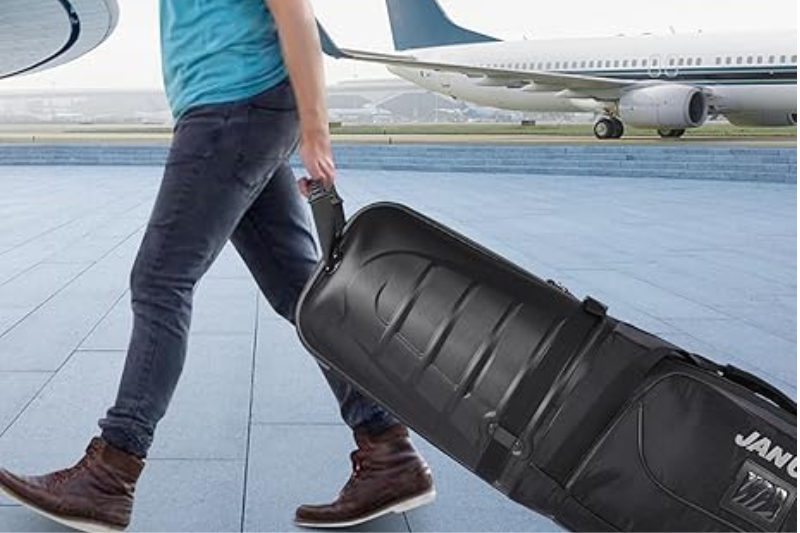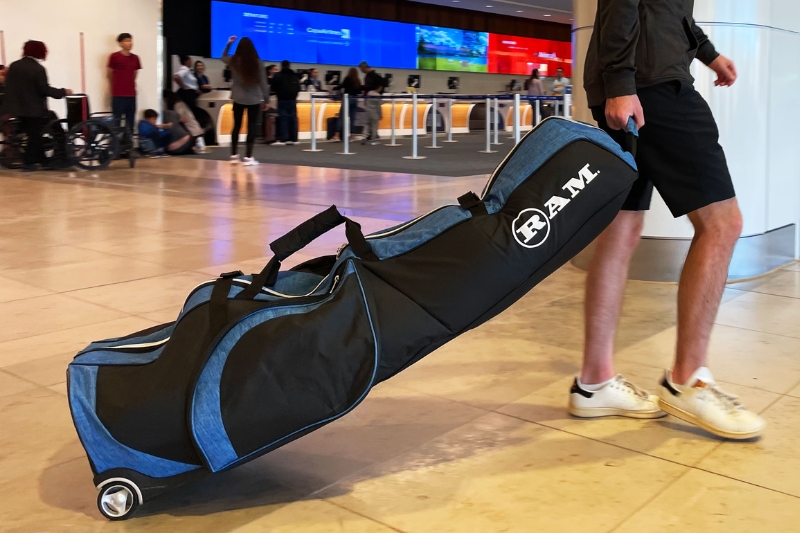For the avid golfer, a trip without your trusty clubs is simply unthinkable. Whether you’re heading to a dream destination for a once-in-a-lifetime golf experience or just a weekend getaway to a local course, packing your clubs for air travel can be a daunting task. Worry not, because with the right knowledge and preparation, you can ensure your prized possessions arrive safely and securely at your destination. This comprehensive guide will equip you with the essential tips and airline rules to pack golf clubs for flight like a pro.
Essential Packing Tips for Golf Clubs on a Flight

Packing golf clubs for a flight requires careful planning and consideration. Here are some essential tips that will help you prepare effectively.
Time Management
When it comes to packing your golf clubs, time is of the essence. Begin the packing process well in advance of your flight. This allows you ample time to address any issues that may arise, such as needing a larger bag or additional packing materials. Rushing through the packing process can lead to mistakes, which could potentially damage your clubs or result in extra fees at the airport.
Understanding Airline Regulations
Every airline has its own regulations regarding golf equipment, including weight restrictions and dimensions. Before you start packing, check the specific rules of your chosen airline well ahead of time. Familiarize yourself with their policies on oversized baggage, fees, and any special handling procedures they may have for sporting equipment. Knowing these details in advance can save you from unexpected surprises at the airport.
Investing in Quality Travel Bags
Don’t skimp on this crucial investment. A durable, well-designed golf travel bag can make all the difference in protecting your clubs during the journey. Look for bags with reinforced padding, sturdy handles, and secure zips. A quality travel bag not only protects your clubs but also makes transporting them much easier. Consider your travel habits and choose a bag that fits your needs, whether it’s a hard-shell case for maximum protection or a soft-shell bag for lighter travel.
Choosing the Right Golf Travel Bag for Air Travel

The first step in packing golf clubs for air travel is choosing the right bag. Here are a few popular options to consider.
Hard-Shell Travel Bags
Hard-shell travel bags offer the ultimate protection against impact damage. Their rigid exterior can withstand the roughest handling, making them ideal for international flights or extended journeys. These bags often come with internal padding and compartments designed specifically for golf clubs, ensuring they remain secure during transit. While they may be heavier than soft-shell options, the peace of mind they provide is often worth the extra weight.
Soft-Shell Travel Bags
Soft-shell travel bags are typically lighter and more compact than hard-shell bags. They usually feature padded compartments and durable zippers for a good level of protection. Some soft-shell bags even offer space for other essential gear like shoes and clothing. If you’re looking for versatility and ease of transport, a soft-shell bag might be the right choice for you. Just ensure that it has adequate padding to protect your clubs from potential impacts.
Carry-On Golf Bags
Carry-on golf bags are smaller, lighter bags designed to fit within airline carry-on size restrictions. While they don’t offer the same level of protection as larger travel bags, they can be a convenient option for shorter trips or if you prefer not to check your clubs. When selecting a carry-on bag, ensure it meets your airline’s specific size requirements, and remember that you may still need to check it if it’s deemed too large for the cabin.
Protecting Your Clubs: Packing Materials and Strategies

Once you’ve selected the right travel bag, it’s crucial to pack your clubs strategically with appropriate materials to ensure maximum protection.
Using Headcovers
Always use headcovers for all your clubs, even if your bag has built-in compartments. They provide an extra layer of protection against scuffs, scratches, and impacts. Headcovers are particularly important for drivers and woods, as their clubheads are more susceptible to damage. Invest in high-quality headcovers that fit snugly over your clubs to prevent them from slipping off during transit.
Adding Extra Padding
Utilize extra padding inside your bag to fill any gaps and reduce movement during transit. Towels, old clothes, or purpose-built padding inserts can effectively cushion your clubs. By minimizing the space between clubs, you decrease the risk of them banging against each other, which can lead to scratches or dents. Make sure to distribute the padding evenly throughout the bag for optimal protection.
Securing Your Clubs
Use straps or bungee cords to secure your clubs inside the bag, minimizing the risk of shifting or rattling during travel. Many travel bags come with built-in straps, but if yours doesn’t, consider purchasing additional straps to keep everything in place. A well-secured set of clubs will not only arrive in better condition but will also make your travel experience smoother.
Airline Regulations and Restrictions for Golf Clubs
Before you embark on your journey, it’s essential to familiarize yourself with the specific rules and regulations governing the transport of golf clubs by your chosen airline.
Weight and Dimension Limits
Airlines have specific weight and size limits for checked baggage, and these restrictions apply to golf club bags. Check with your airline for accurate information. Exceeding these limits can result in hefty fees, so it’s best to weigh your bag before heading to the airport. Additionally, ensure that your bag’s dimensions comply with the airline’s guidelines to avoid complications during check-in.
Fees and Surcharges
Many airlines charge an extra fee for carrying golf clubs as oversized or overweight baggage. Factor these costs into your travel budget. Some airlines may have specific fees for sporting equipment, while others may include them under standard baggage fees. Always confirm the charges associated with transporting your golf clubs to avoid surprises at the airport.
Pre-Booking Requirements
In some cases, airlines require you to pre-book your golf clubs as oversized baggage, especially for international flights. This means you should inform the airline about your golf clubs when you book your ticket. Pre-booking helps ensure that there’s enough space allocated for your equipment and can streamline the check-in process.
Packing Your Golf Clubs for Maximum Protection

Following these steps ensures your clubs are safely secured for your flight.
Preparation Steps
Remove any loose items from the bag. Clean and dry your clubs to prevent corrosion or damage from dust or moisture. Secure your driver with a protective wrap or bubble wrap. Use golf club headcovers designed for travel for additional protection. Taking these preparatory steps can significantly enhance the safety of your clubs during transit.
Strategic Packing Techniques
Position your clubs in the bag strategically, minimizing any gaps between them. Utilize padding around clubs to absorb shocks and vibrations. Pack heavier clubs towards the bottom of the bag, balancing the weight distribution. This not only helps protect your clubs but also makes the bag easier to handle. A well-packed bag will be less likely to tip over or become unbalanced during transport.
Final Checks
Ensure all zippers and fastenings on your bag are properly closed and secured. Check for any loose items or objects that could move during the flight. Add a personalized tag or label with your contact information to your bag. Taking these final checks can give you peace of mind as you head to the airport.
Tips for Packing Your Golf Gear Beyond the Clubs
Golf clubs are not the only essential items for a successful golf trip. Don’t forget to pack these other important things.
Packing Golf Shoes
Pack your golf shoes in a separate shoe bag or compartment to avoid damaging other items in your luggage. Ensure they’re clean and dry to prevent any odor. If you have multiple pairs of shoes, consider bringing only what you need for the trip to save space in your travel bag.
Selecting Appropriate Golf Apparel
Pack lightweight, breathable golf clothing that’s appropriate for the weather conditions at your destination. Depending on the climate, you may need to bring layers or waterproof gear. Always check the forecast before you leave to ensure you’re prepared for any weather changes during your trip.
Bringing Golf Accessories
Pack all your essential golf accessories, such as tees, divot tools, ball markers, and a rangefinder, in a small pouch or bag. Keeping these items organized will save you time on the course and ensure you have everything you need for a successful round of golf.
Safely Navigating Airport Security with Golf Clubs
Navigating airport security with golf clubs can be a breeze if you’re prepared.
Pre-Screening Services
Before arriving at the airport, check if your airline offers a pre-screening service for golf clubs. This service allows you to screen your clubs in advance, reducing delays at the security checkpoint. If available, take advantage of this service to streamline your airport experience.
Smart Packing for Security
Keep essential items easily accessible to avoid unnecessary delays during the security screening process. Place your golf clubs in a way that allows for easy removal if needed. Being organized can help you move through security more efficiently and reduce stress.
Patience is Key
Expect additional scrutiny for golf clubs during the security check. Stay calm and be prepared to answer questions from security personnel. Understanding that golf clubs may require extra attention can help you maintain a positive attitude during the process.
Minimizing the Risk of Damage During Transit
While it’s impossible to completely eliminate the risk of damage during air travel, these strategies can help to minimize it.
Choosing Direct Flights
If possible, choose a direct flight to minimize the number of times your bag is handled during transit. Fewer transfers mean less opportunity for your clubs to be mishandled or damaged. If direct flights are not an option, try to limit layovers to reduce handling.
Investing in High-Quality Bags
As mentioned earlier, a high-quality golf travel bag with adequate padding can prevent scratches and dents during the journey. Investing in a durable bag is one of the best ways to protect your clubs. Look for bags that have been tested for durability and customer reviews that speak to their effectiveness.
Strategic Packing Techniques
Pack your clubs carefully with padding and secure them with straps to minimize movement within the bag. The more secure your clubs are, the less likely they are to sustain damage during transit. Take the time to pack thoughtfully, and your clubs will thank you upon arrival.
The Importance of Labeling and Identification
Even if you’re confident in your packing skills, a good label and identification can make all the difference.
Personalized Tags
Attach a personalized tag with your name, address, and contact information to your golf travel bag. This helps airline staff identify your belongings in case of mishandling. Having clear identification can expedite the recovery process if your bag gets lost.
Choosing Visible Tags
Choose a tag that’s easily recognizable and visible. Consider using a bright color or a large, easily readable font. A distinctive tag can help you spot your bag quickly on the baggage carousel and reduce the chances of someone else mistakenly taking it.
Consider Using GPS Trackers
In today’s tech-savvy world, consider investing in a GPS tracker for your golf bag. These devices can help you locate your bag if it goes missing during transit. While they won’t prevent loss, they can provide peace of mind knowing you can track your belongings.
Travel Insurance and Golf Club Coverage
While not mandatory, travel insurance offers valuable protection against unforeseen events like lost or damaged luggage.
Coverage for Lost or Damaged Clubs
Many travel insurance policies cover loss or damage to golf clubs during transit, providing financial compensation to replace them. Review your policy carefully to understand what is covered and any limitations that may apply. Having this coverage can alleviate concerns about the safety of your clubs during travel.
Peace of Mind
Travel insurance can provide peace of mind knowing that you are protected against unforeseen circumstances that could impact your golf trip. Whether it’s a delayed flight, lost luggage, or damaged clubs, having insurance can help you focus on enjoying your trip rather than worrying about potential mishaps.
Variety of Coverage Options
Travel insurance policies offer a range of coverage options for different needs and budgets. Choose a policy that aligns with your specific requirements. Compare different providers and read customer reviews to find the best fit for your travel plans.
Conclusion
By following these essential tips and understanding airline regulations, you can confidently pack your golf clubs for your next flight, ensuring they arrive safely and securely at your destination. Remember, preparation is key to a stress-free and enjoyable golf trip. With the right travel bag, packing techniques, and knowledge of airline rules, you’ll be ready to hit the greens wherever your travels take you. Happy golfing!

I am the owner of Ricks Golf Shop, a popular destination for golf enthusiasts. My passion for golf began in my teenage years and has only grown over the years. With over 10 years of experience in the golf industry, I offer expert advice and quality products. With a friendly demeanor and extensive knowledge, I ensure every customer leaves happy.
